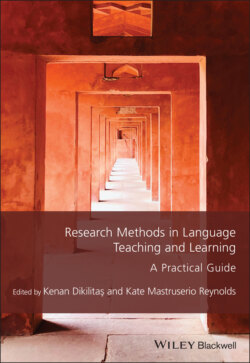Читать книгу Research Methods in Language Teaching and Learning - Группа авторов - Страница 21
Collecting and Analyzing Data, and Writing up the Research
ОглавлениеIn collecting data, I employed the three key methods discussed by Stake (1995) that are characteristic of qualitative case study research: observations, in which my own role was as a “non-participant observer” (Cohen et al., 2011); semi-structured interviews (Kvale, 1996); and documentary analysis. I used these methods as follows.
While observing in schools, I kept an open narrative record, jotting down descriptive notes relating to actions and reactions, movement, words spoken by teacher and learners, and written on the whiteboard; this commentary was punctuated occasionally by exclamations and questions to remind me of key incidents later. Post-observation discussions were held immediately afterwards in the quietest room we could find and audio-taped on micro-cassette with the teacher’s permission. I elicited feelings about the lesson, memories, reactions, highlighting key incidents and inviting reflection on them, teasing out evidence, encouraging links to public theory and summarizing. While we talked, I added to observation notes, in different colored ink, as exclamations and questions were dealt with. Next, I had prepared questions relating specifically to my research to ask, these generally having arisen from data analysis, reading since the last interview, theorizing, and reflection. I approached this semi-structured phase flexibly, in terms of the order in which questions were asked and the way in which topic areas were explored through follow-up questions, aiming to follow “quality” procedures (Kvale, 1996).
I also analyzed documents, chiefly the teachers’ written assignments, many of which encouraged both engagement with theory and reflection on the planning, implementation, and evaluation of tasks, materials, and activities. These documents included action research dissertations and earlier proposals for these. Analyzing these documents allowed me to compare the participating teachers’ written words with their observed actions and their reports in interview, which would facilitate not only “methodological triangulation,” but also “data source triangulation,” since I would be able to explore changes over time (Stake, 1995).
The data analysis, which was “interactive” and “iterative” (Lincoln & Guba, 1985), informed successive rounds of data collection, and progressed through stages. Observation notes were written up within a few hours, as Stake (1995) recommends, and audio-recorded interviews were also quickly transcribed. This enabled me to use the data “to think with” (Hammersley & Atkinson, 1995). I coded in relation to my research questions, reading and rereading the corpus of data, revised research sub-questions in relation to each teacher to cover emerging patterns and themes, and created categories. I then adopted a “template approach” (Robson, 2002), with key codes, determined by research questions and sub-questions, serving as a template into which coded text segments were placed, which created a matrix. This allowed for the data to be read in a way that facilitated the move from coding to interpretation.
This analytical process supported the making of “thick description” (Geertz, 1973), which involved selecting, organizing, and presenting “interconnected data” (Holliday, 2002) in a way that aimed to support vicarious experience. The narratives I developed, drawing on the different sources of interconnected data, aimed to render the concrete particularities of experience immediate and employ verbal imagery that appealed to the senses (Clandinin & Connelly, 1990). Feedback on draft narratives from PhD supervisors and a critical friend familiar with the context, who together could supply a degree of “investigator triangulation” (Stake, 1995), suggested a need for more analytical commentary to be woven into the writing, which I supplied. I subsequently engaged in “member checking” (Stake, 1995), sharing drafts with research participants, achieving, through this process, a degree of pragmatic and communicative validation (Kvale, 1996). For example, in one case, not only could the research participant
confirm that the story was accurate, but in the way he engaged with it he assumed a kind of ownership for it. He developed, too, not just his understanding of research as he discussed the text with me, but the member checking process also seemed to heighten his awareness of his own development.(Wyatt, 2008, p. 67).
However, a methodological limitation was that I was unable to conduct meetings for the purpose of “member checking” with all the research participants; the schools were closed in July 2006 when I was doing this, and for cultural reasons I could not have met the female research participants in other locations. They were nevertheless sent drafts, with invitations for written comments, and I received some feedback.
